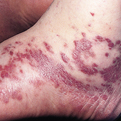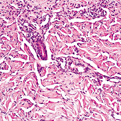Kaposi’s Sarcoma
General Information
Kaposi’s Sarcoma (KS) is a disease in which cancer cells are found in the tissues under the skin or mucous membranes that line the mouth, nose, and anus. The disease causes red or purple patches (lesions) on the skin and/or mucous membranes that spread to other organs in the body, such as the lungs, liver, or intestinal tract. There are several forms of KS that are based primarily on cause rather than appearance. Classic Kaposi Sarcoma is found mainly in Mediterranean males, mid-European Jewish heritage, organ transplant patients or young adult African men. AIDS-related Kaposi sarcoma is associated with human immunodeficiency syndrome (HIV) infection and acquire immunodeficiency syndrome (AIDS), especially among homosexual men. The lesions may be disfiguring but they are not life threatening or disabling. In most cases, the lesions are asymptomatic. When the lesions are in the lungs, liver or gastrointestinal tract they do become life threatening. For example if the lesions are on the lungs it can cause difficulty breathing, if located in the gastrointestinal tract they can produce bleeding. In Classic Kaposi Sarcoma, patients typically have one or more lesions on the hands and arms and legs, ankles, or the soles of the feet. The lesions slowly grow and new lesions may develop over the course of 10 to 15 years. Pressure from the lesions can block lymph vessels causing swelling that may be painful. Lesions can also develop in the gastrointestinal tract, lymph nodes, and elsewhere in the body, although they rarely cause symptoms. African (or endemic) Kaposi sarcoma is identical to classic KS, although it usually develops at a much younger age. Typically, African (endemic) KS causes asymptomatic lesions and do not spread to other parts of the body. However, cases that are more aggressive do occur, and some skin tumors may penetrate the underlying bone. Another form of the disease strikes children before puberty and usually involves the lymph nodes and other organs. Transplant-Related (Acquired) Kaposi Sarcoma normally develops in people whose immune systems have been suppressed after an organ transplant. Often, transplant-related KS affects only the skin. In some cases, though, the disease can spread to the mucous membranes or other organs. AIDS-Related (Epidemic) Kaposi Sarcoma develops in people who are infected with the human immunodeficiency virus (HIV). The four treatments used to treat KS are surgery, chemotherapy, radiation therapy, and biological therapy. There cases where two or more of the treatments are used simultaneously. In patients who have, KS because they have received an organ transplant, switching to the anti-rejection drug sirolimus has been very effective.
Epidemiology
Classic Kaposi Sarcoma mostly affects elderly men of Mediterranean or Jewish heritage, organ transplant patients, or young adult African men. In the last 20 years, however, most KS cases have developed in association with human immunodeficiency virus (HIV
Etiology
Virus called the Kaposi sarcoma-associated herpesvirus (KSHV), also known as human herpesvirus 8 (HHV-8)
Pathogenesis
Develops in connective tissues such as cartilage, bone, fat, muscle, blood vessels, or fibrous tissues (related to tendons or ligaments).
Clinical
Patches are usually red or purple and are made of cancer cells and blood cells
Histology
Vascular formations with predominance of endothelial cells, and spindle cell formations containing vascular slits. In addition, an inflammatory reaction may be observed in early lesions, giving some of them the appearance of granulation tissue.
Bibliography
1. “Detailed Guide: Kaposi Sarcoma” (Online). http://www.cancer.org/docroot/CRI/CRI_2_3x.asp?rnav=cridg&dt=21 (visited: March 20, 2008) 2. “Kaposi’s Sarcoma” (Online). http://www.healthscout.com/ency/68/297/main.html#DefinitionofKaposi (visited: March 20, 2008)
Download PDF
![]() Kaposi’s Sarcoma
Kaposi’s Sarcoma


